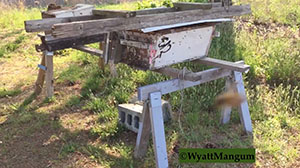
After a long day of teaching, Suzanne and I finally arrived home. As usual, she checked the answering machine while I scampered away. Hearing her calling me, and hearing something about a swarm, a sensitive word in the spring, I knew my workday was not over. Replaying the message, it seemed like the bees were taking too long to go in one of my swarm-catching (bait) hives. At least the swarm was not going the other way, flying off to the woods. In a few minutes, I was out the door and gone in the bee truck.
Approaching the apiary (see Figure 1) slowly in the bee truck, I could see a big swarm cloud flying around the bait hive, which was just beyond the row of hives. I stopped the truck well away from the apiary, not wanting to disturb the bee flight, which might interfere with subtle details of what was occurring. With only an iPhone, no bee smoker, veil, or the other usual gear, I walked ahead of the truck, into the swirl of bees. I let their flight pattern guide my eyes (see Figure 2).
From the six entrance holes at the end of the bait hive, hundreds of bees boiled out, frantic to leave, like the hive would explode in seconds (see Figures 3 and 4). Most likely, the swarm did not get the queen in the hive. Realizing that, instantly, I froze, not taking another step. The queen might be on the ground, close by. I did not want to step on her. Quickly, I scanned the ground, mostly bare, locating her in seconds.
To search for a lost queen, don’t do it alone –– let the swarm help you. Typically, some swarm bees have already found her. So do not look for one bee, the queen bee. Rather look for a small cluster of bees, even a little notch of bees; check through them.
Sure enough, several feet away was a little cluster of bees spread out, round like a small dish. Something down in the dark center of those bees held their attention like an invisible magnet (see Figure 5).
Under the confused hum of the swarm cloud, I began gently nudging away the excited bees. If the swarm repeatedly launched to the bait hive, probably from right here on the ground, only to abandon it because of a missing queen, she might be defective in some way.
Once I collected a big swarm on a city sidewalk. The bees had spread out on the cement like a large round pizza. Instead of just running the bees right into my catch hive, I picked through them, searching for the queen, knowing she would be small, nimble and ready to fly like a virgin queen ready for her mating flight.
Beginning about ten days before the swarm’s departure, the mother queen begins losing weight. She is preparing for the tumultuous fission event, when thousands of bees split their society. The former slow-moving queen, heavy with eggs, darts from the entrance. Light and nimble, almost like a worker bee, the small swarm queen flies off in the maelstrom of bees.
In a few minutes, I found the queen in the sidewalk swarm. As expected, the little queen was small enough to fly. Except she had a bad problem. Her wings were gone! The queen had only tiny chewed-off nubs. Her wee little nubs quivered when she got excited, or wanted to fly, a pitiful sight. Wing damage, that extensive, could result from hostile treatment by worker bees. I remembered my next thought. The parent colony must be close by. And it was, a bee tree by the sidewalk.
Another time I found a flightless swarm was when I had my 200 top-bar colonies pollinating field crops in North Carolina. The swarm was right in front of a hive in a big apiary of 50 hives. Half of the swarm had crawled up under the hive, braiding itself into the weeds and spider webs. Capturing this swarm would be difficult. I had to pick through the bees to make sure I had the queen.
It took a while, but I finally found the queen. The hunt was worth it, because I had never found a swarm queen like this one before. The queen was full of eggs, like a regular laying queen, of course way too heavy to fly. She was a swarm queen trying to fly as a laying queen (called a physogastric queen). Immediately, I had to know: What was the developmental state of the queen cells used by the bees to swarm with such a physogastric queen?
(Queen cells built for swarming are succinctly called swarm cells. Normally, when the bees cap the first swarm cells, the swarm departs soon after. I have seen swarms routinely delay their departure well into the pupation time of the swarm cells. In contrast, I have found rare colonies that swarmed without capped swarm cells. Their swarm cells had just older larvae, about a day from capping.)
Remarkably, the swarm cells with the swarm half under the hive contained only –– eggs. Not even one larva. The swarm cells appeared more like queen cell cups, slightly extended. In all my years of beekeeping, I had never observed that, swarming with only eggs in the swarm cells.
Remembering these past ordeals, I wondered what kind of problem queen might occur in this current case, as I sorted through the excited bees. They constantly ran all over my fingers, buzzing their wings. I just let them be and slowed my ….


